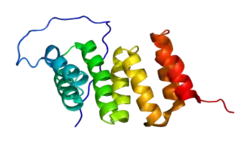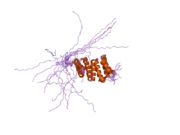UNC45A
Protein unc-45 homolog A is a protein that in humans is encoded by the UNC45A gene.[5][6]
| UNC45A | |||||||||||||||||||||||||||||||||||||||||||||||||||
|---|---|---|---|---|---|---|---|---|---|---|---|---|---|---|---|---|---|---|---|---|---|---|---|---|---|---|---|---|---|---|---|---|---|---|---|---|---|---|---|---|---|---|---|---|---|---|---|---|---|---|---|
 | |||||||||||||||||||||||||||||||||||||||||||||||||||
| |||||||||||||||||||||||||||||||||||||||||||||||||||
| Identifiers | |||||||||||||||||||||||||||||||||||||||||||||||||||
| Aliases | UNC45A, GC-UNC45, GCUNC-45, GCUNC45, IRO039700, SMAP-1, SMAP1, UNC-45A, unc-45 myosin chaperone A, OOHE | ||||||||||||||||||||||||||||||||||||||||||||||||||
| External IDs | OMIM: 611219 MGI: 2142246 HomoloGene: 32423 GeneCards: UNC45A | ||||||||||||||||||||||||||||||||||||||||||||||||||
| |||||||||||||||||||||||||||||||||||||||||||||||||||
| |||||||||||||||||||||||||||||||||||||||||||||||||||
| |||||||||||||||||||||||||||||||||||||||||||||||||||
| |||||||||||||||||||||||||||||||||||||||||||||||||||
| |||||||||||||||||||||||||||||||||||||||||||||||||||
| Wikidata | |||||||||||||||||||||||||||||||||||||||||||||||||||
| |||||||||||||||||||||||||||||||||||||||||||||||||||
References
- GRCh38: Ensembl release 89: ENSG00000140553 - Ensembl, May 2017
- GRCm38: Ensembl release 89: ENSMUSG00000030533 - Ensembl, May 2017
- "Human PubMed Reference:". National Center for Biotechnology Information, U.S. National Library of Medicine.
- "Mouse PubMed Reference:". National Center for Biotechnology Information, U.S. National Library of Medicine.
- Price MG, Landsverk ML, Barral JM, Epstein HF (Oct 2002). "Two mammalian UNC-45 isoforms are related to distinct cytoskeletal and muscle-specific functions". J Cell Sci. 115 (Pt 21): 4013–23. doi:10.1242/jcs.00108. PMID 12356907.
- "Entrez Gene: UNC45A unc-45 homolog A (C. elegans)".
Further reading
- Bazzaro M, Santillan A, Lin Z, et al. (2008). "Myosin II Co-Chaperone General Cell UNC-45 Overexpression Is Associated with Ovarian Cancer, Rapid Proliferation, and Motility". Am. J. Pathol. 171 (5): 1640–9. doi:10.2353/ajpath.2007.070325. PMC 2043524. PMID 17872978.
- Ewing RM, Chu P, Elisma F, et al. (2007). "Large-scale mapping of human protein–protein interactions by mass spectrometry". Mol. Syst. Biol. 3 (1): 89. doi:10.1038/msb4100134. PMC 1847948. PMID 17353931.
- Olsen JV, Blagoev B, Gnad F, et al. (2006). "Global, in vivo, and site-specific phosphorylation dynamics in signaling networks". Cell. 127 (3): 635–48. doi:10.1016/j.cell.2006.09.026. PMID 17081983.
- Chadli A, Graham JD, Abel MG, et al. (2006). "GCUNC-45 Is a Novel Regulator for the Progesterone Receptor/hsp90 Chaperoning Pathway". Mol. Cell. Biol. 26 (5): 1722–30. doi:10.1128/MCB.26.5.1722-1730.2006. PMC 1430258. PMID 16478993.
- Gerhard DS, Wagner L, Feingold EA, et al. (2004). "The Status, Quality, and Expansion of the NIH Full-Length cDNA Project: The Mammalian Gene Collection (MGC)". Genome Res. 14 (10B): 2121–7. doi:10.1101/gr.2596504. PMC 528928. PMID 15489334.
- Colland F, Jacq X, Trouplin V, et al. (2004). "Functional Proteomics Mapping of a Human Signaling Pathway". Genome Res. 14 (7): 1324–32. doi:10.1101/gr.2334104. PMC 442148. PMID 15231748.
- Ota T, Suzuki Y, Nishikawa T, et al. (2004). "Complete sequencing and characterization of 21,243 full-length human cDNAs". Nat. Genet. 36 (1): 40–5. doi:10.1038/ng1285. PMID 14702039.
- Strausberg RL, Feingold EA, Grouse LH, et al. (2003). "Generation and initial analysis of more than 15,000 full-length human and mouse cDNA sequences". Proc. Natl. Acad. Sci. U.S.A. 99 (26): 16899–903. Bibcode:2002PNAS...9916899M. doi:10.1073/pnas.242603899. PMC 139241. PMID 12477932.
This article is issued from Wikipedia. The text is licensed under Creative Commons - Attribution - Sharealike. Additional terms may apply for the media files.





